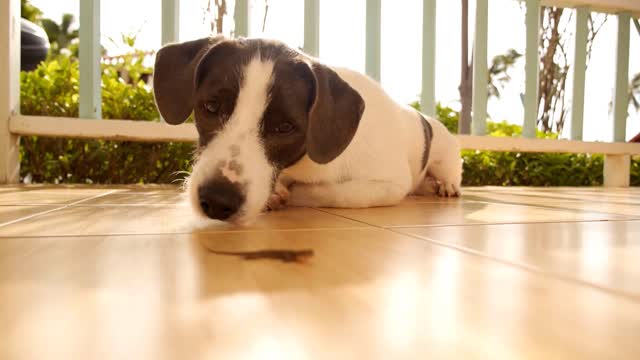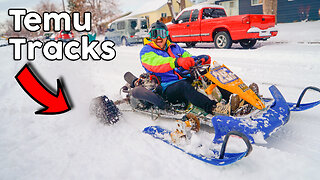Premium Only Content

Blindness in dogs.
Blindness in dogs.
When searching for "what causes blindness in dogs", one of the first results is always canine cataracts. The eye has a lens called the lens of the eye, which is responsible for providing focus and allowing distances to be recognized. In the case of a dog's cataract, the lens fibers are damaged and, as a result, the animal loses its sense of space and orientation. A classic sign of the cataract in dogs is the opaque eye, because the death of the cells creates a kind of film that prevents the passage of light. The disease may have a genetic origin or be a consequence of diseases such as canine diabetes, trauma, and infection.
Canine glaucoma is one of the main causes of blindness in dogs. The disease occurs when there is an overproduction of the fluid that lubricates the eye, increasing intraocular pressure. The dog with glaucoma has corneal blurring, redness around the eye, excessive tearing, and an increase in eye size. In severe cases, the animal may lose its vision completely. The cause of glaucoma can be hereditary or a consequence of diseases such as cataracts or tumors in the region. The treatment is complicated and usually the doctor prescribes special eye drops, but in certain situations it is necessary to remove the eye.
Throughout life, certain situations such as injury, trauma, or contact with dust that carries viruses and bacteria can lead to inflammation in different parts of the eye. When the inflamed region is the conjunctiva (the membrane that protects the eyes), a condition called canine conjunctivitis develops. Uveitis in dogs, on the other hand, is caused by inflammation of the uvea (layer that allows vascularization of the eye). And if the inflammation attacks the cornea (the outermost part of the eye), we have keratitis or corneal ulcer in dogs. Keratitis is one of the most common causes of blindness in dogs, since the cornea is the outermost part of the eye that protects the eye well. It can be treated, but you need to act fast. Conjunctivitis and uveitis are less likely to make the dog blind, but if there is no proper treatment, the animal can indeed lose its vision.
Many times the blindness in a dog - puppy or adult - does not occur because of a specific eye disease or trauma. It is common for diseases that start in other parts of the body to progress to the point of reaching the dog's eye. This is the case with canine diabetes. The diabetic dog has an excess of glucose in the blood that damages the blood vessels in the eyes, leaving the dog blind - in fact, most diabetic dogs go blind. Another disease that usually has blindness in dogs as a consequence is tick disease. The condition attacks various parts of the body as it progresses and can reach the eyes.
The retina is the part of the eye where images are formed by means of photoreceptors that capture light. In progressive retinal atrophy, these photoreceptors degenerate. As they are responsible for the formation of images, the dog goes blind with time. This is a genetic disease and of difficult perception, because the pet has no apparent symptoms. What happens is that he starts to see very badly (being even worse in the dark) and, in some cases, can develop cataracts. This is not a type of disease for which blindness in dogs can be cured. Unfortunately, the pet that is born with the condition loses its sight throughout its life and it is not possible to recover it.
As we can see, there are numerous answers to the question "what can cause blindness in dogs". In some cases, it is possible to do a surgery that reverses the condition. Thus, the blind dog can see again or have a prosthesis that helps him to see again. However, blindness in dogs is not always curable. When we have a blind dog, it is necessary to adapt the whole house and routine to make his life more comfortable. The collar for blind dogs is an essential item in the life of a dog that can't see. It helps the pet to get around better by providing a barrier that prevents the animal from bumping into walls and furniture.
There are different models of collar for blind dogs, such as the version with an attached bow (like a visor) and the one that produces vibrations when it gets close to some obstacle to alert the doguinho. Besides the collar for blind dogs, it is worth investing in other items that improve the safety of the blind dog at home, such as gates and non-slip socks. Organize the furniture in a way to avoid as much as possible that the pet bumps into and whenever someone arrives home, let them know that the pet can't see. With these adaptations, the blind dog can live with much more comfort and practicality.
-
 0:28
0:28
Cowboy671
2 years ago $0.01 earnedC17 Blindness backing 1
55 -
 8:31
8:31
Cybersecurity & SOC 2 Simplified
3 years agoPen Test to Remove Security Blindness
43 -

BonginoReport
4 hours ago“Liberation Day”: Trump Champions Economic Nationalism - BR Early Edition w/Evita (Ep.174)
43.9K28 -
 LIVE
LIVE
Wendy Bell Radio
5 hours agoThe One Thing Democrats Will Never Stand Up For Is America
9,367 watching -
 1:17:06
1:17:06
Dear America
11 hours agoRINOS Vote WITH Dems Against Trump Tariffs + Girl Refuses To Compete With Biological Male?!
10.7K8 -
 LIVE
LIVE
2 MIKES LIVE
1 hour agoTHE MIKE SCHWARTZ SHOW with DR. MICHAEL J SCHWARTZ 04-03-2025
111 watching -
 1:29:02
1:29:02
Game On!
15 hours ago $3.02 earnedAntonio Brown was RIGHT! Rodgers signing with Steelers is IMMINENT!
17.7K6 -
 10:18
10:18
Friday Beers
15 hours agoWe Became the Highest Paid Street Performers in Los Angeles
33.5K12 -
 19:01
19:01
World2Briggs
13 hours ago $7.18 earnedMove Here Before It’s Too Late! 10 Future Boomtowns in the U.S.
31.3K19 -
 8:50
8:50
The Rad Factory
20 hours ago $6.27 earnedShifter Kart on Snow Tracks Rips City Streets
35.7K21